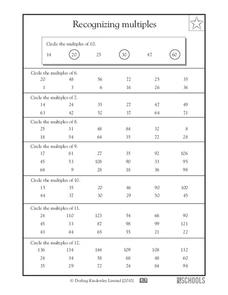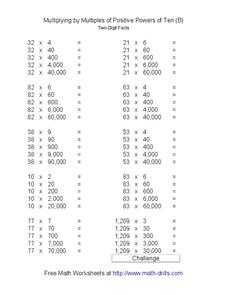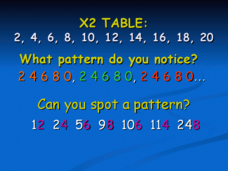Curated OER
Recognizing Multiples
Can your fourth graders recognize multiples of 10? What about 11 and 12? Use this worksheet to enhance your multiplication lesson, or to assess what your math students already know about finding multiples. Given six sets of numbers, they...
Curated OER
Recognizing Multiples
By asking learners to identify multiples of 6, 7, and 8, you will be able to assess their grasp of these multiplication facts. For each of these numbers learners examine five set of digits and circle the multiples from the sets. A final...
Curated OER
Multiples
Explore multiples of three and four with 18 sets of numbers. Learners examine each row and circle the multiples of three (for the first nine) and four (for the last nine). There is an example as reference, however none of these are...
Curated OER
What's My Calculation?
Learners play a simple multiplication game in which they look at the number on each of the slides, and write down the multiplication facts that would give them that number. For example, 24 could get four different factor pairs. Fun...
Curated OER
Multiplying by Negative Powers of Ten (B)
For this negative powers of ten worksheet, youngsters multiply one-digit numbers by powers of ten ranging from 1 to .0001. This two-page worksheet contains approximately 50 problems, with answers.
Curated OER
Multiplying by Negative Powers of Ten (A)
Learners multiply two-digit numbers by powers of ten ranging from 1 to 0001. This two-page worksheet contains approximately 50 problems, with answers.
Curated OER
Multiplying by Multiples of Positive Powers of Ten (B)
Young scholars multiply two-digit numbers by powers of ten ranging from one to 90,000. This two-page worksheet contains approximately 50 problems, with answers.
Curated OER
Multiplying by Multiples of Positive Powers of Ten (C)
Here is a powers of ten worksheet in which learners multiply two-digit numbers by powers of ten ranging from one to five digits. This two page worksheet contains approximately 50 problems, with answers.
Curated OER
Multiplying by Positive Powers of Ten (E)
For this powers of ten worksheet, pupils multiply two-digit numbers containing powers of ten ranging from one to 10,000. This two-page worksheet contains 50 problems, with answers.
Curated OER
Multiplying by Positive Powers of Ten (D)
Upper elementary and middle school learners multiply two-digit numbers by powers of ten ranging from the number 1 to 10,000. This two-page worksheet contains approximately 50 problems, with answers.
Curated OER
Multiples of 2, 5, and 10
Build number sense and make learning multiples a simple task with this helpful presentation. The multiples of two, five, and ten are represented first as number patterns. Learners will be able to construct rules based on what they see....
Curated OER
Dividing by Negative Powers of Ten (B): Two-Digit Facts
For this math worksheet, students are given 10 numbers which they are to divide by 1, .1, .01, .001, and .0001. Once the procedure is understood, the answers are easy to find.
Curated OER
Multiplying by Multiples of Negative Powers of Ten (E)
In this powers of ten instructional activity, learners multiply single-digit numbers by multiples of negative powers of ten. This two-page instructional activity contains approximately 50 problems, with answers.
Curated OER
Multiplying by Multiples of Positive Powers of Ten (C)
In this powers of ten instructional activity, students multiply single-digit whole numbers by positive powers of ten. This two-page instructional activity contains approximately 50 problems, with answers.
Curated OER
Multiplying by Multiples of Negative Powers of Ten (B)
In this powers of ten activity, students multiply single-digit numbers by negative powers of ten. This two-page activity contains approximately 50 problems, with answers.
Curated OER
Multiplying by Negative Powers of Ten (C)
In this powers of ten worksheet, students multiply two-digit whole numbers times decimal numbers ranging from 1 to .0001. This two-page worksheet contains approximately 50 problems. A separate answer sheet is provided.
Curated OER
Dividing by Multiples of Positive Powers of Ten (C): Single-Digit
Learners can practice their positive powers of ten in this activity, in which they are given 10 numbers to divide by a set of multiples in the format x, x0, x00, x000, x0,000. A challenge question is available to further test your...
Curated OER
Multiplying by Multiples of Positive Powers of Ten (B)
In this powers of ten worksheet, students multiply single-digit whole numbers by multiples of powers of ten. This two-page worksheet contains approximately 50 problems, with answers.
Curated OER
Dividing by Powers of Ten (B)
In this powers of ten worksheet, students divide three to ten-digit whole numbers by powers of ten. This two-page worksheet contains approximately 50 problems, with answers.
Beacon Learning Center
Ten Pins
Multiplying with multiples of 10, 100, and 1,000 provides an opportunity to discuss patterns that arise with zeros. The class uses these patterns to solve problems. Then they rotate through three work stations, including a computer-based...
Curated OER
Problem Solving: 100 Board Logic Problems
Get mathematicians engaged with number terminology using this puzzle activity! Learners determine the selected number from a hundred board by eliminating numbers using clues. As a group, each learner has a specific role, outlined in the...
Primary Junction
Adding Tens
Build on your learners' confidence in quick addition as they discover strategies to add tens to two-digit numbers. After reviewing counting by 10's, they discuss tactics to add multiples of 10 to other numbers. They visualize how to...
Curated OER
Multiples
A great learning exercise for scaffolding critical thinking about mathematical concepts. This resource provides students with a brief explanation of multiples followed by 29 practice problems which gradually increase in difficulty....
Curated OER
Adding and Subtracting Fractions
For this fractions worksheet, students solve and complete 20 different problems that include adding and subtracting various fractions. First, they use the given equivalents to add and subtract the first row of fractions. Then, students...

























